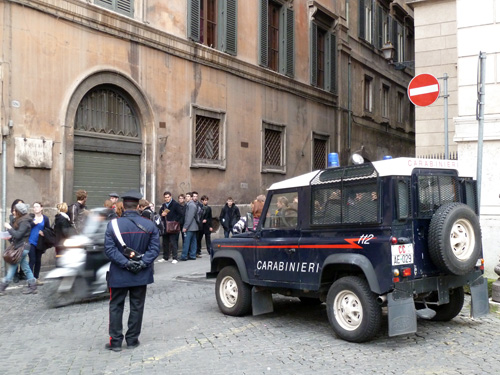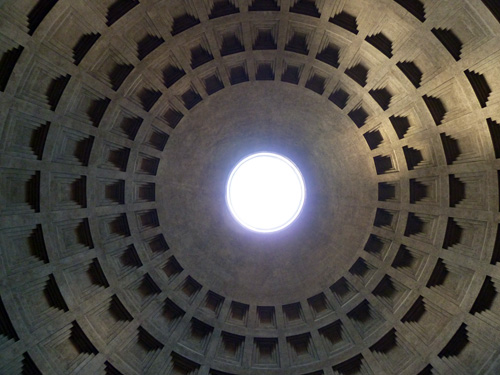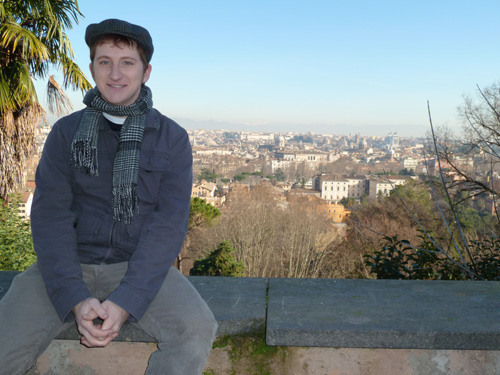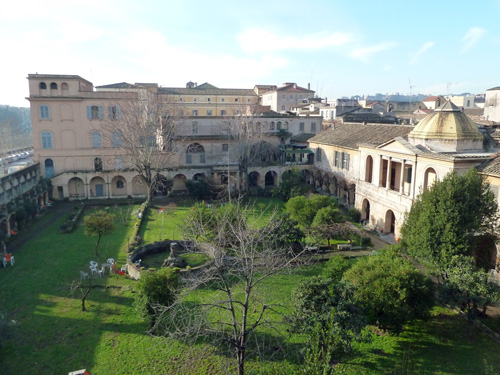Sorry for the long break from writing…classwork became a bit of an obstacle to blogging during the past two weeks. Anyway, I’m finally getting to posting about Oslo, and well as blogging about some things in Roma:
My travels began with the best Christmas present ever, a 10-day tour through Norway, Finland, and Switzerland with two of my compadres and fellow architecture students, George and Matt. We flew out of Philly on December 27, barely dodging the blizzard that canceled flights throughout the east coast during Christmas weekend. After enduring delays, a very bumpy trip over the North Sea, and a sprint through Charles de Gaulle Airport to catch our connecting flight, we arrived in Oslo…without our checked luggage. But with the promise of our belongings’ expeditious return, we ventured into the Oslo winter.
Conveniently, our hostel was located a block from the central rail station, so we took a high-speed bullet train from the airport to the Sentrum. Since we hadn’t had a real meal in over a day, we went in search of some hearty Norwegian fare. George, Matt and I settled on Kaffistova – a bit like a Scandinavian Panera Bread – and enjoyed a traditional Christmastime meal of meatballs, sausage, boiled potatoes, and sauerkraut. Unfortunately, we discovered that despite that the Norwegian currency, the krona, is worth 6 cents apiece, prices in Norway are hyperinflated, and each of our ‘modest’ meals cost almost $30. However, unlike airline food, it was filling and delicious!
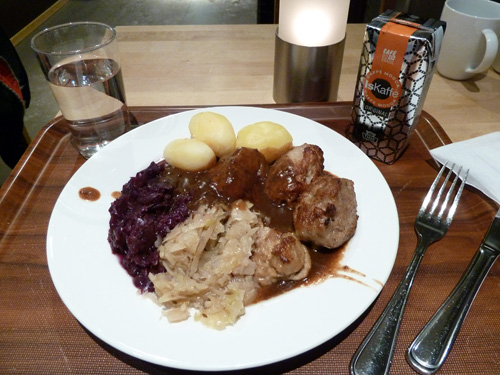
Before crashing for the night, we looked around downtown Oslo for a bit. We saw the antique
Freia sign advertising a Norwegian candy bar; Norway’s parliament, the
Stortinget; and the
Norwegian royal palace. Similar to Great Britain and other constitutional monarchies, Norway has a king, Harald V. Although he mainly serves as a ceremonial figurehead, the king is the royal patron of the Norwegian Lutheran Church and the Supreme Commander of the Norwegian military.
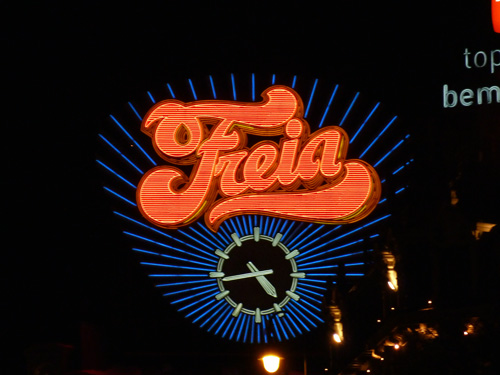
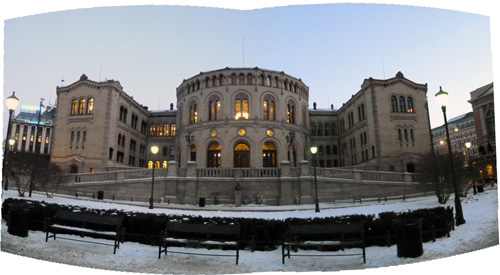
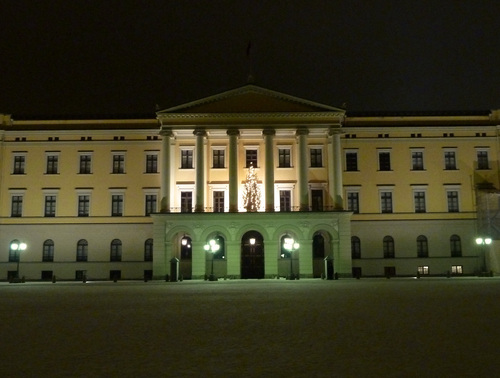 We awoke the next day to the disappointing news that our bags still hadn’t been delivered to the hostel, meaning we still didn’t have any fresh clothes. We did our best to make ourselves appear clean, then went out to see the Vikingskiphuset (Viking ship museum). The museum houses 3 Viking burial ships dating to the 9th Century, which were recovered from the seafloor of the Oslofjord. Viking cheiftans, queens, and respected warriors were laid to rest in elaborately carved battleships, surrounded by earthly goods that could be used in Valhalla. These ships were then sunk to the bottom of the sea with massive millstones. The most famous ship on display is the nearly-complete Oseberg ship:
We awoke the next day to the disappointing news that our bags still hadn’t been delivered to the hostel, meaning we still didn’t have any fresh clothes. We did our best to make ourselves appear clean, then went out to see the Vikingskiphuset (Viking ship museum). The museum houses 3 Viking burial ships dating to the 9th Century, which were recovered from the seafloor of the Oslofjord. Viking cheiftans, queens, and respected warriors were laid to rest in elaborately carved battleships, surrounded by earthly goods that could be used in Valhalla. These ships were then sunk to the bottom of the sea with massive millstones. The most famous ship on display is the nearly-complete Oseberg ship:
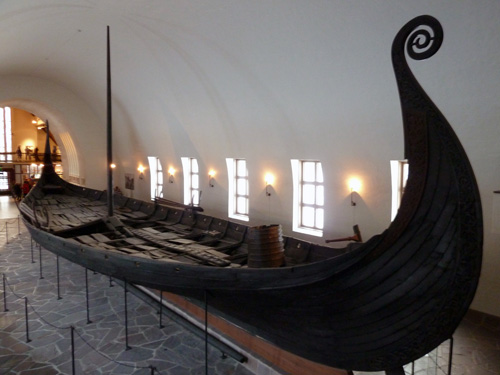 After the Viking ship museum, we visited the neighboring Norwegian Folk Museum, which features an architectural park with a collection of traditional Norwegian houses, businesses, and churches. It was a bit like visiting Colonial Williamsburg, only with buildings from throughout Norway’s history instead of a single time period. I really enjoyed seeing the museum’s Stavkirke, because very few of these wooden churches have survived to the present day, and most are in rural areas of the country that we wouldn’t be visiting.
After the Viking ship museum, we visited the neighboring Norwegian Folk Museum, which features an architectural park with a collection of traditional Norwegian houses, businesses, and churches. It was a bit like visiting Colonial Williamsburg, only with buildings from throughout Norway’s history instead of a single time period. I really enjoyed seeing the museum’s Stavkirke, because very few of these wooden churches have survived to the present day, and most are in rural areas of the country that we wouldn’t be visiting.
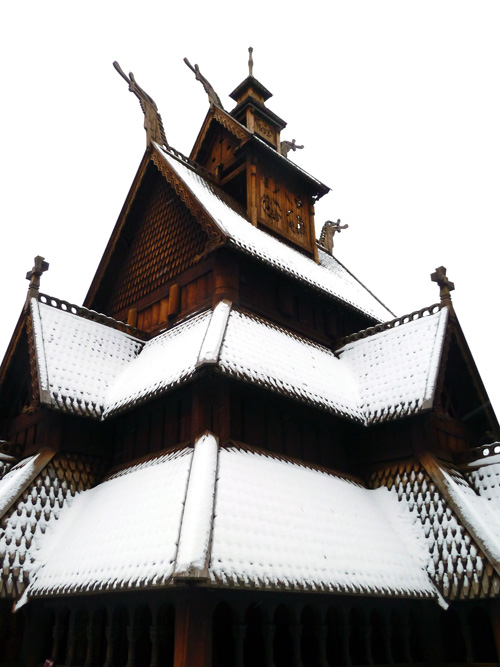
That night, we had dinner at a traditional seafood restaurant, Dovrehallen, at the recommendation of the hostel proprietor – appropriate, given Oslo’s role as a fishing hub. Apparently, we blended in pretty well with the locals; our waiter began explaining the night’s specials to us in rapid-fire Norwegian, until we explained that we weren’t fluent, and he sheepishly repeated himself in flawless English (most Norwegians can speak at least a little). After dinner, we visited Oslo City Hall, the site of the annual Nobel Peace Prize ceremony:
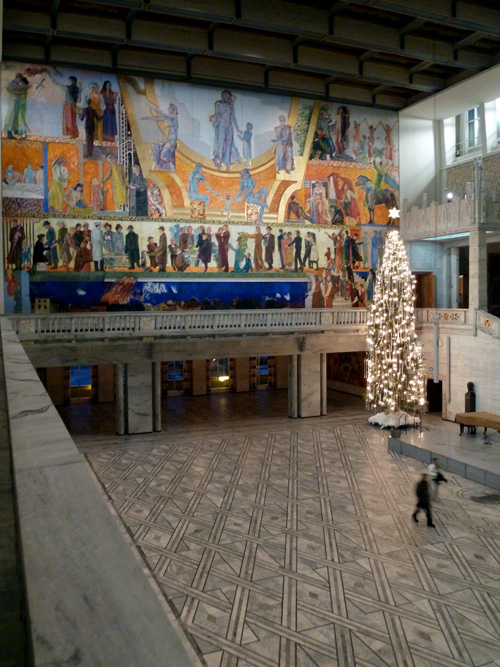 We began our final day in Oslo with a visit to Akershus Castle, the medieval stronghold of Norway’s kings, still wondering if we would ever see our luggage again. The fortress is still considered one of the king’s official residences, and many members of the Norwegian royal family are buried in the castle’s chapel. The fortress was key to Norway’s military resistance to Nazi occupation during WWII; militiamen firing from the castle sank a German U-boat in the Oslofjord before it could reach the city’s harbor.
We began our final day in Oslo with a visit to Akershus Castle, the medieval stronghold of Norway’s kings, still wondering if we would ever see our luggage again. The fortress is still considered one of the king’s official residences, and many members of the Norwegian royal family are buried in the castle’s chapel. The fortress was key to Norway’s military resistance to Nazi occupation during WWII; militiamen firing from the castle sank a German U-boat in the Oslofjord before it could reach the city’s harbor.
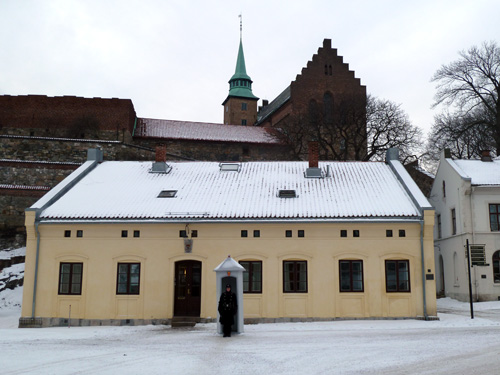 Our final stop in Oslo was the Norwegian National Opera, designed by Oslo architects Snohetta (being architecture students, we had hoped to visit Snohetta’s offices, but had to cancel those plans due to our unkempt appearance). The opera house is the newest and most instantly recognizable landmark in Oslo, a giant iceberg of white marble and glass, rising from the harbor shore. The building opened in 2007 to a great deal of critical praise; it seamlessly blends modernism with unique Scandinavian craftsmanship and imagery, and boasts one of the most technically-advanced performance halls in Europe. It also provided the Opera with a permanent home for the first time in its history. The building’s most notable feature is its sloping roof, which can be climbed by the public. The afternoon that we toured the opera house, the roof was filled with visitors seeking views of the Oslofjord, or maybe just a good sledding hill in the city:
Our final stop in Oslo was the Norwegian National Opera, designed by Oslo architects Snohetta (being architecture students, we had hoped to visit Snohetta’s offices, but had to cancel those plans due to our unkempt appearance). The opera house is the newest and most instantly recognizable landmark in Oslo, a giant iceberg of white marble and glass, rising from the harbor shore. The building opened in 2007 to a great deal of critical praise; it seamlessly blends modernism with unique Scandinavian craftsmanship and imagery, and boasts one of the most technically-advanced performance halls in Europe. It also provided the Opera with a permanent home for the first time in its history. The building’s most notable feature is its sloping roof, which can be climbed by the public. The afternoon that we toured the opera house, the roof was filled with visitors seeking views of the Oslofjord, or maybe just a good sledding hill in the city:
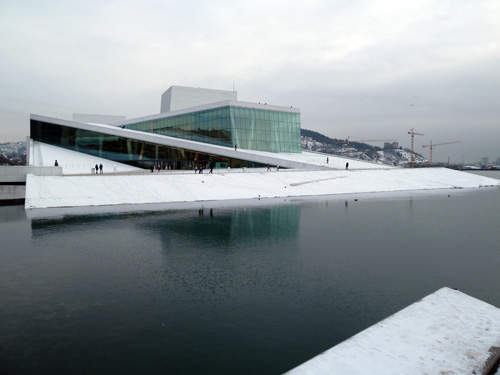 After visiting the opera house, we went back to the hostel to grab our carry-on bags, certain that we wouldn’t be seeing the rest of our luggage until we arrived in Helsinki. But, sure enough, we returned to find that the baggage handlers had left our stuff on the hostel doorstep, and just in the nick of time. With that, we were off to Finland…
After visiting the opera house, we went back to the hostel to grab our carry-on bags, certain that we wouldn’t be seeing the rest of our luggage until we arrived in Helsinki. But, sure enough, we returned to find that the baggage handlers had left our stuff on the hostel doorstep, and just in the nick of time. With that, we were off to Finland…
Location: Sentrum, Oslo, Norway
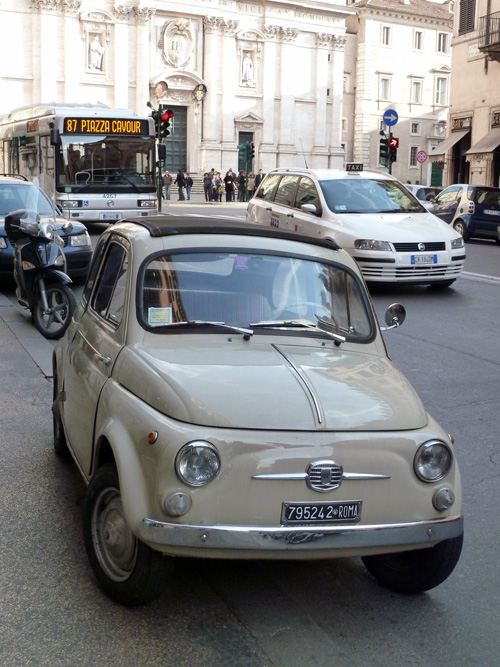 Matchbox car?
Matchbox car?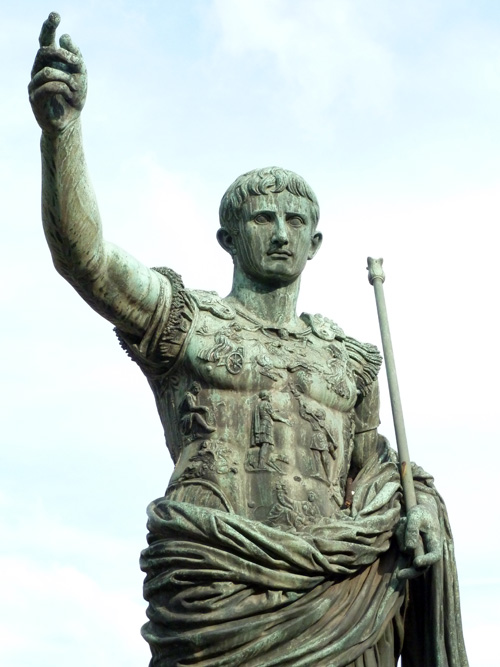
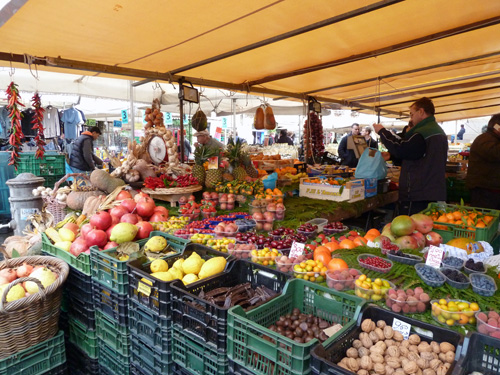 Tutti Frutti
Tutti Frutti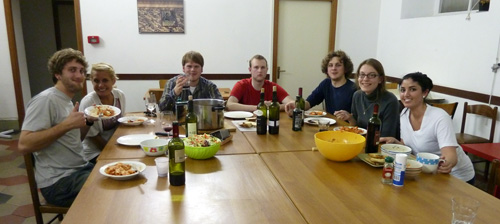 Rome sweet Rome
Rome sweet Rome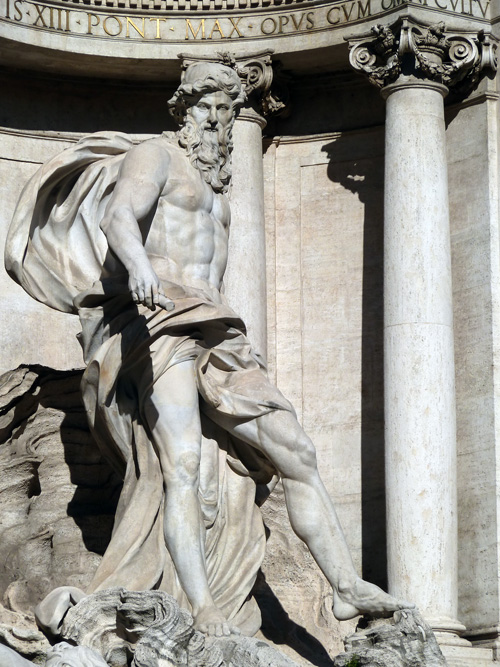 Salty Seagod
Salty Seagod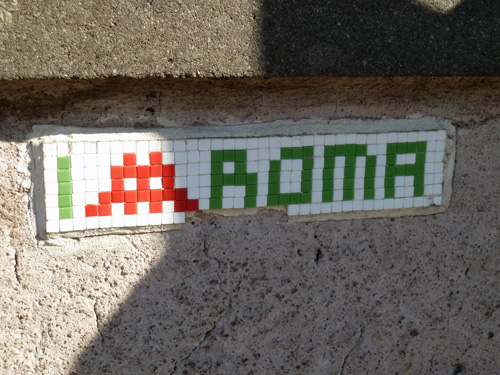 It(alien) Invaders
It(alien) Invaders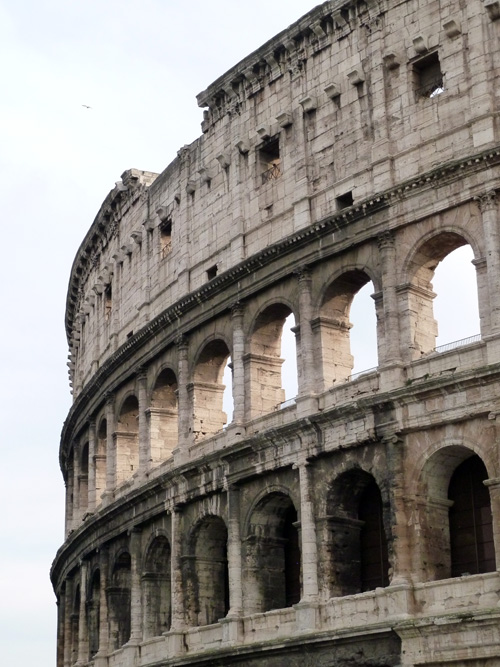 But can it seat me and 110,000 of my best friends?
But can it seat me and 110,000 of my best friends?

